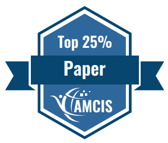Healthcare Informatics & Health Information Technology (SIG Health)
A Bayesian Network Model to Establish a Digital Twin Architecture for Superior Falls Risk Prediction
Paper Type
Complete
Paper Number
1119
Description
Implementing digital twin technology as an abstraction from the reality of physical systems for real-time evaluation of trends and outcomes has dominated the manufacturing sector, but its importance in healthcare cannot be overemphasized. We develop a digital twin architecture using a Bayesian network approach for establishing the predisposition of patients to falls risk on admission. This framework provides decision support for seamless management of inpatients' falls risk acuity by interfacing patients' clinical, demographic, and psychosocial attributes with a Bayesian network for pattern classification to predict falls risks levels. By using the Synthetic Minority Oversampling Technique (SMOTE) to upsize the minority falls risk class, it was possible to enhance the prediction accuracy of falls risk vulnerability after a case study with real hospital data. Our results show that the chances of optimizing patients' experience with the digital twin framework are very high because of the enhanced management of falls risk on admissions.
Recommended Citation
Ossai, Chinedu and Wickramasinghe, Nilmini, "A Bayesian Network Model to Establish a Digital Twin Architecture for Superior Falls Risk Prediction" (2021). AMCIS 2021 Proceedings. 3.
https://aisel.aisnet.org/amcis2021/healthcare_it/sig_health/3
A Bayesian Network Model to Establish a Digital Twin Architecture for Superior Falls Risk Prediction
Implementing digital twin technology as an abstraction from the reality of physical systems for real-time evaluation of trends and outcomes has dominated the manufacturing sector, but its importance in healthcare cannot be overemphasized. We develop a digital twin architecture using a Bayesian network approach for establishing the predisposition of patients to falls risk on admission. This framework provides decision support for seamless management of inpatients' falls risk acuity by interfacing patients' clinical, demographic, and psychosocial attributes with a Bayesian network for pattern classification to predict falls risks levels. By using the Synthetic Minority Oversampling Technique (SMOTE) to upsize the minority falls risk class, it was possible to enhance the prediction accuracy of falls risk vulnerability after a case study with real hospital data. Our results show that the chances of optimizing patients' experience with the digital twin framework are very high because of the enhanced management of falls risk on admissions.
When commenting on articles, please be friendly, welcoming, respectful and abide by the AIS eLibrary Discussion Thread Code of Conduct posted here.



